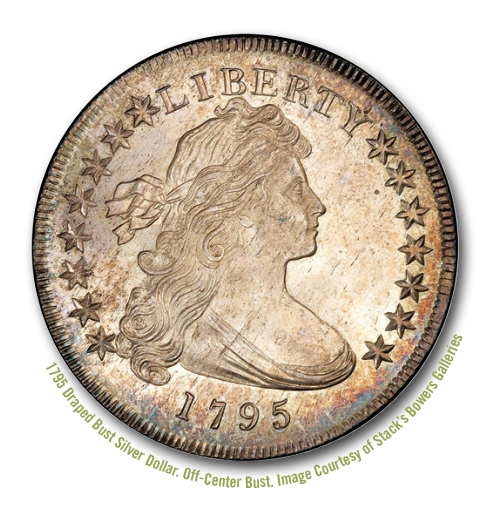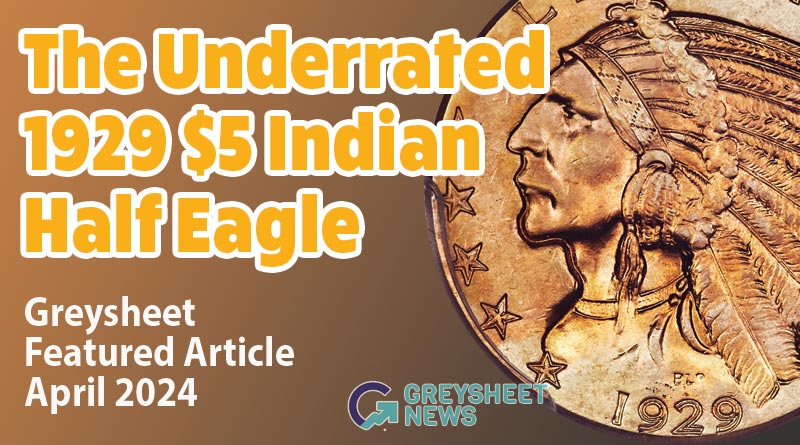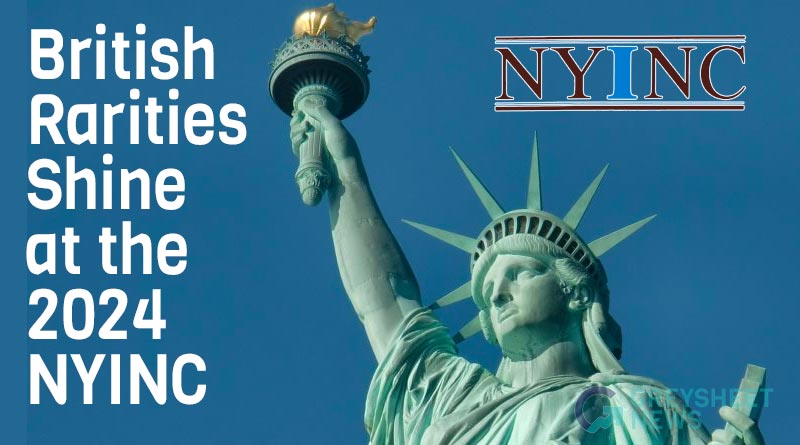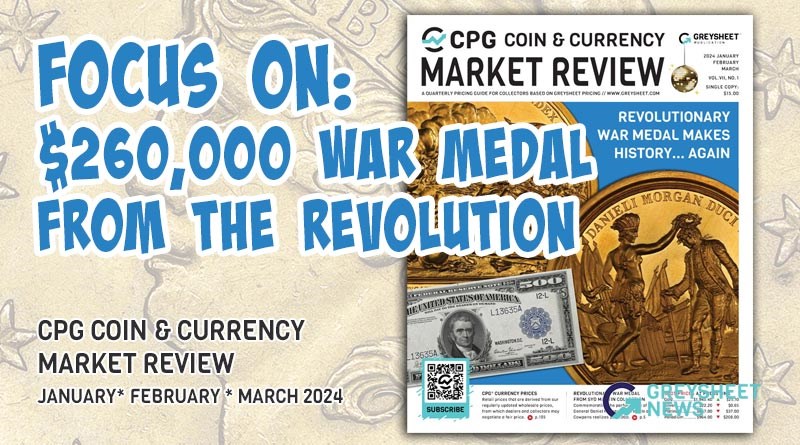SERIES ANALYSIS: Early Silver Dollars, Draped Bust 1795-1798 (Part 2)
Part 2 of Greg Reynolds series analysis on the draped bust silver dollars that were issued from 1795-98. These are also know as "small eagle reverse" dollars and quite popular among collectors.
This article appeared in print in the November 2019 issue of The Monthly Greysheet.
From 1795 to 1798, silver dollars were minted with a Draped Bust obverse and a so called ‘Small Eagle’ reverse. This eagle motif is not really small; it is just called a small eagle to distinguish it from the grand style ‘Heraldic Eagle’ reverse that was introduced later. A list of design types of silver dollars appears in my article in last month’s Greysheet.
Of Draped Bust, Small Eagle silver dollars, ten major varieties are listed in the Greysheet and these are widely accepted:
- 1795 Off-Center Bust
- 1795 Centered Bust
- 1796 Small Date, Small Letters
- 1796 Small Date, Large Letters
- 1796 Large Date, Small Letters
- 1797 9×7 Stars, Small Letters
- 1797 9×7 Stars, Large Letters
- 1797 10×6 Stars
- 1798 15 stars
- 1798 13 Stars
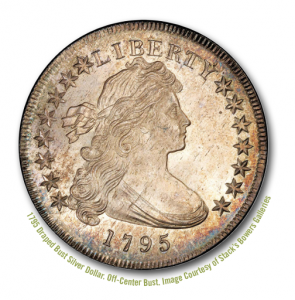 The names “Small Letters” and “Large Letters” refer to the size of the letters in the legend, ‘UNITED STATES OF AMERICA,’ on the reverse. The difference in size is readily noticeable, and the large letters are much closer to nearby dentils.
The names “Small Letters” and “Large Letters” refer to the size of the letters in the legend, ‘UNITED STATES OF AMERICA,’ on the reverse. The difference in size is readily noticeable, and the large letters are much closer to nearby dentils.
The notation ‘9×7′ refers to obverse dies where nine stars are at the left of the collector viewing the coin and seven stars are at the right. There are thus nine stars to the left of the letters of Liberty and seven to the right, for a total of sixteen, the number of states in the union at the time. On June 1, 1796, Tennessee became the sixteenth state. The notation ’10×6’ refers to an arrangement where ten stars are on the left and the other six stars are on the right, from the perspective of someone viewing coins.
More than one thousand 1795 Draped Bust silver dollars exist in the present. For the off-center variety, the bust of Miss Liberty was accidentally punched too far to the left, and her hair touches or just about touches the first star. A ribbon is close to the fifth star. There is a considerable amount of space between Miss Liberty’s face and the stars at the right. On the centered bust variety, a garment on Miss Liberty’s chest touches or just about touches the the sixteenth star, the bottom star at the right. On the off-center bust variety, in contrast, there is noticeable space between the sixteenth star and Miss Liberty’s chest.
According to the September Greysheet, the centered bust and off-center 1795 Draped Bust dollars are worth around the same amounts in grades from G4 to AU50. My view, in contrast, is that, all other factors being more or less equal, the centered bust 1795 dollars are significantly scarcer and are worth more in most all grades. Indeed, the Centered bust 1795 dollars tend to bring more at auction, but the physical characteristics of each individual 1795 Draped Bust dollar affect its value more so than whether it is a centered bust or an off-center bust variety.
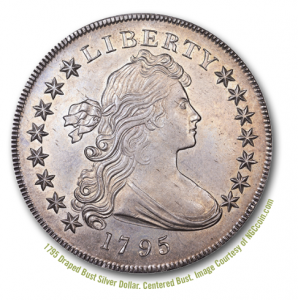 PCGS did not distinguish centered from off-center busts in their data for many years. Consequently, the PCGS population now for centered bust 1795 Draped Bust dollars includes a substantial number of off-center bust dollars that were graded before these two varieties were classified separately at PCGS.
PCGS did not distinguish centered from off-center busts in their data for many years. Consequently, the PCGS population now for centered bust 1795 Draped Bust dollars includes a substantial number of off-center bust dollars that were graded before these two varieties were classified separately at PCGS.
It makes sense to list a few public auction and Internet sale results to provide an idea of current values and availability. It is important to keep in mind that each coin is distinctive and bidding competition varies in magnitude and depth. Auction results should not be thought of as conclusive indicators of wholesale or retail values; auction prices need to be analyzed along with additional information.
In March 2018, Stack’s-Bowers auctioned a PCGS graded VG10 1795 Off-Center Bust dollar for $2.160. On June 7, 2019, at a Long Beach Expo, Heritage auctioned a PCGS graded Fine-12 1795 Off-Center Bust dollar for $3.360, more than the $2.620 result for a PCGS graded F15 Off-Center Bust in the FUN event in January 2019.
In April 2019, Heritage auctioned a PCGS graded XF40 1795 Off-Center Bust silver dollar for $8,400. Heritage had earlier auctioned the exact same coin for $6,756.25 in January 2016. On March 14, 2019, Heritage auctioned a PCGS graded XF40 1795 Off-Center Bust for $6,600 and a PCGS graded XF45 1795 Off-Center Bust for $7,800.
In Heritage sales last autumn, an NGC graded VF30 1795 Off-Center Bust brought more, $4,560, than a PCGS graded VF30 1795 Off-Center Bust, $4,200. On Sept. 5, 2019, at a Long Beach Expo, a PCGS graded VF-35 Off-Center Bust dollar realized $5,040.
In August 2019 at an ANA Convention, a PCGS graded XF45 1795 Off-Center Bust was auctioned for $9,300, which seems to be a retail-level price. At the FUN event in January 2019, an NGC graded AU50 1795 Off-Center Bust dollar brought $9,000.
Budget-minded collectors may like to know that an NGC graded Fair-02 1795 Centered Bust dollar was auctioned by Stack’s-Bowers for $1,057.50 back in August 2017. It is curious that, on July 12, 2018, Heritage sold two 1795 Centered Bust dollars for the same price, each for $7,200, yet one was PCGS graded XF40 and the other was PCGS graded XF45. In August 2018, Stack’s-Bowers auctioned a PCGS graded AU53 1795 Centered Bust dollar for $13,200.
In uncirculated grades, 1795 dollars are the least rare of the Draped Bust, Small Eagle design type. For the whole design type, PCGS has assigned mint state grades (MS60 or higher) to only sixty-two coins, and NGC to sixty-nine coins. The combined total of one hundred and thirty-one probably amounts to fifty-five to seventy different coins. There is much demand for these, and collectors should consult experts before acquiring one. Prices may range from $60,000 to more than $1 million!
Of all varieties of 1796 silver dollars, there are fewer than a dozen that are truly mint state. Of all three major varieties, 1796 dollars that are PCGS or NGC graded from VF20 to AU50 are somewhat available. Also, there are more than two hundred ungradable 1796 silver dollars around.
On April 21, 2019, the firm of GreatCollections sold an NGC graded F15 1796 dollar for $2,707.88. Although not designated as such, this 1796 appears to be of the Small Date, Large Letters variety.
In July 2019, at the Summer FUN Convention, Heritage auctioned a PCGS graded XF45 1796 Small Date, Small Letters dollar for $11,400. The exact same coin realized $13,800 in a Heritage event in December 2010.
On July 14, 2019, the firm of David Lawrence sold a PCGS graded VF30 Small Date, Large Letters 1796 dollar for $4,700. On June 23, 2019, GreatCollections sold a PCGS graded XF40 Small Date, Large Letters dollar, with a CAC sticker, for $9,590.62.
As all 1796 dollars with a Large Date on the obverse have “Small Letters” on the reverse, there is no need to mention the small letters when referring to the large date. On August 14, 2019, Stack’s-Bowers sold a PCGS graded VF30 coin for $4080. Almost exactly one year earlier, Stack’s-Bowers auctioned an NGC graded XF45 1796 Large Date for $7,800.
In grades below AU50, a 1797 9×7 stars, Large Letters dollar or a 1797 10×6 would cost around the same as a 1796 silver dollar. In April 2019, Heritage auctioned a PCGS graded F15 1797 9×7, Large Letters silver dollar for $3,360.
On August 25, 2019, GreatCollections sold a PCGS graded XF40 1797 9×7, Large Letters coin for $8,010. On August 15, 2019, Stack’s-Bowers auctioned a PCGS graded AU53 1797 9×7, Large Letters, for $12,000 and a PCGS graded AU55 coin that was struck from the same pair of dies, for $31,200.
The 1797 9×7 stars obverse, Small Letters reverse, major variety is worth a substantial premium over the 1797 9×7, Large Letters and over the 1797 10×6. This premium tends to be very substantial, percentage-wise, for coins that grade above XF40.
I estimate that fewer than one hundred and thirty different 1797 9×7 Small Letters dollars have been assigned numerical grades by PCGS or NGC, and another forty-five to sixty-five coins have been or would be found to be non-gradable by both services. It is noteworthy that just nine have received stickers of approval from CAC.
There is only one mint state 1797 9×7 Small Letters silver dollar certified by PCGS or NGC, and it is the only uncirculated representative of this major variety that I have ever seen or heard about. It was NGC graded MS64 and CAC approved before the auction of most of Eric Newman’s early U.S. silver coins in November 2013. This 1797 9×7 Small Letters dollar then realized $381,875.
After crossing into a PCGS holder, this finest known 1797 9×7 Small Letters dollar realized considerably less, $264,000, in an auction in November 2017. This weak to moderate result is curious. While market levels have fallen since November 2013, a mild retail price now would not be much different from a mild retail price for this coin in November 2017, in the range of $320,000 to $400,000.
Noticeably circulated 1797 9×7 Small Letters dollars can be found without too much difficulty. On June 22, 2018, Stack’s-Bowers auctioned a PCGS graded G6 1797 9×7 Small Letters dollar for $2,280. In February 2019, Heritage auctioned an NGC graded F15 coin of this major variety for $3,120.
The total number of surviving 1798 Small Eagle dollars is much lower than the total of all 1797 Small Eagle dollars extant. Heraldic, “Large Eagle” bust silver dollars were also minted in 1798.
There are two major varieties of 1798 Small Eagle dollars, those with thirteen stars (7 left, 6 right) on the obverse and those with with fifteen stars (8 left, 7 right) on the obverse. I maintain that the fifteen stars variety is much scarcer overall. Price guides, however, tend to value these about the same in grades below AU50.
In January 2018, Heritage sold a PCGS graded VF20 1798 13 Stars coin for $4,080. On July 14, 2019, the firm of David Lawrence sold a PCGS graded VF30 1798 13 Stars coin for $5,000. On February 28, 2019, Stack’s-Bowers auctioned two PCGS graded XF40 15 stars variety 1798 Small Eagle dollars, in consecutive lots. The first brought $13,200 and the second, $8,400. To understand the value and quality of an individual coin, there is often a need to examine it in actuality.
In sum, a set of all ten major varieties of Draped Bust, Small Eagle silver dollars is a practical objective. Not one is an extreme rarity.
Collectors focusing upon coins that grade above AU53 should hire at least one expert for advice and other services. Analyzing high grade early U.S. coins is very difficult and requires years of experience.
A collector who builds a set without a paid consultant should endeavor to personally examine a large number of bust dollars, and to ask many pertinent questions. Invariably, most early silver dollars have been cleaned or mistreated at one time or another. It is important to discuss the nature and degree of past cleanings, dippings, and natural retoning. For well circulated pieces, mildly awkward colors stemming from past cleanings are considered normal and are usually not that important.
It is fortunate that thousands of Draped Bust, Small Eagle silver dollars survive. These attractive, 18th century U.S. coins may be studied and enjoyed by a substantial number of collectors and other coin enthusiasts.
# # #
©2019 Greg Reynolds
Insightful10@gmail.com

Download the Greysheet app for access to pricing, news, events and your subscriptions.
Subscribe Now.
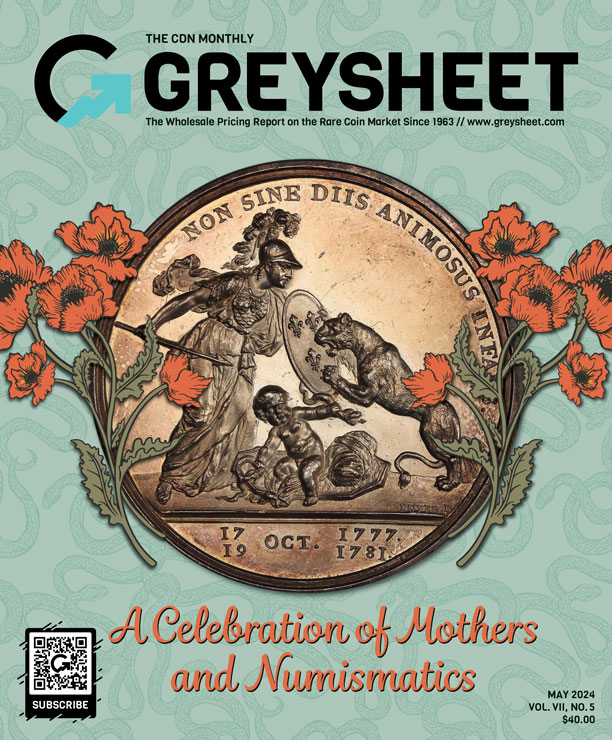
Subscribe to Monthly Greysheet for the industry's most respected pricing and to read more articles just like this.
Source: Greg Reynolds


